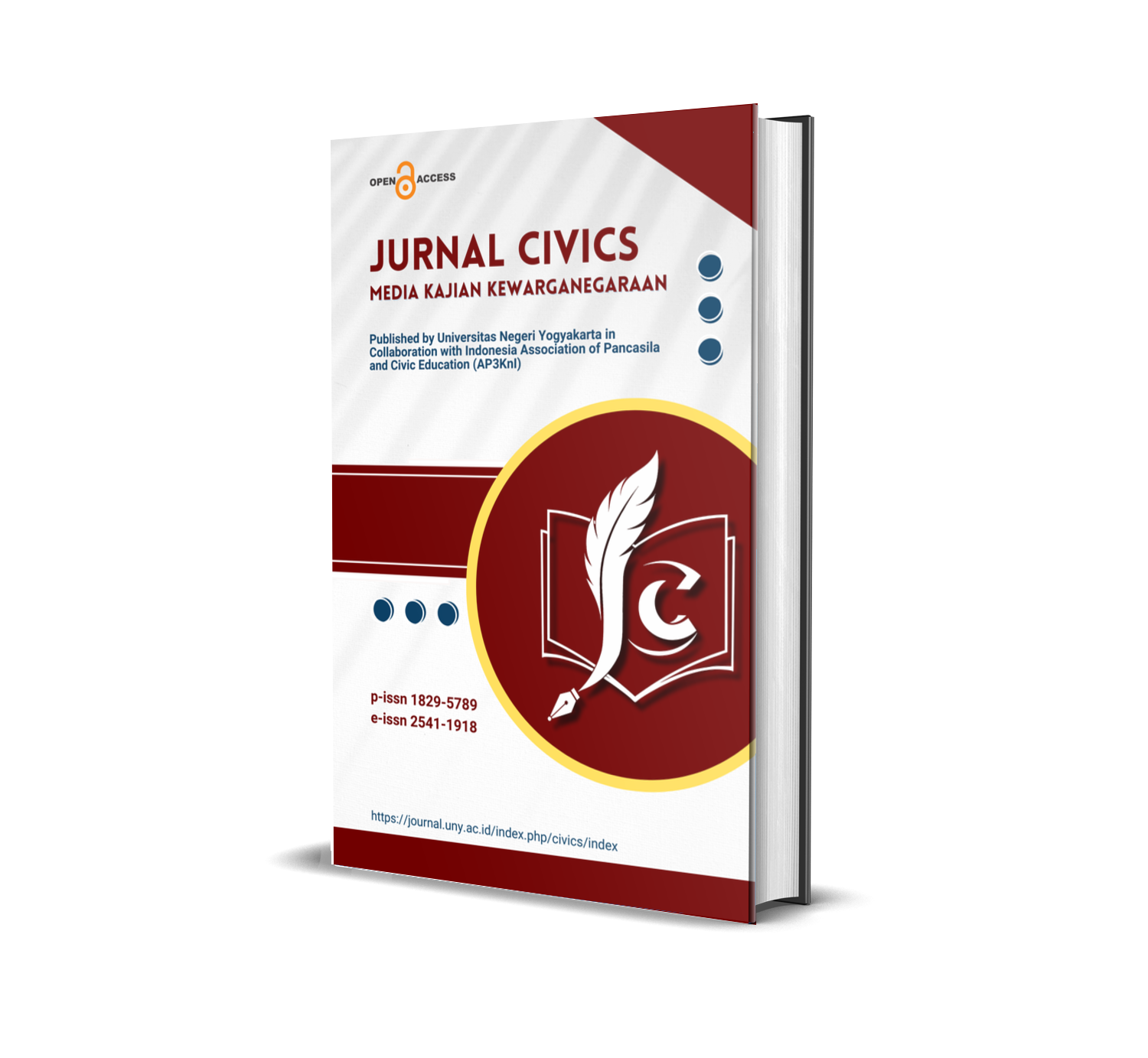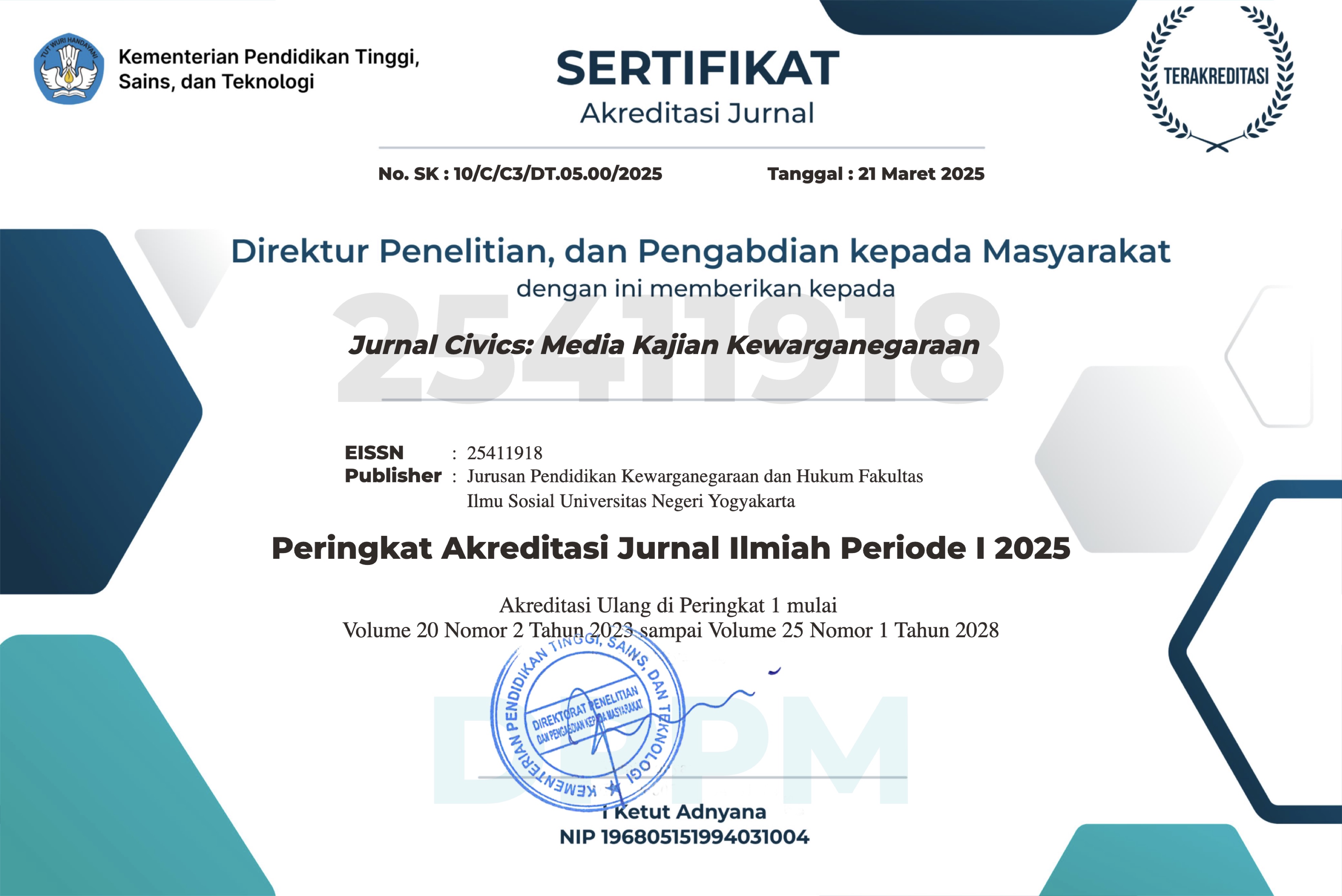Development of alternative models for early detection of religiously legitimated anarchism in Bali Province
DOI:
https://doi.org/10.21831/jc.v19i1.47492Keywords:
anarchism, radicalism, terrorismAbstract
The long-term goal of this research is to develop a model for preventing radicalism in the Bali Region. This research used a front-ended prototype studies development approach. The data in this study were collected by: (1) observation guidelines, (2) clinical interview guidelines, (3) questionnaires, (4) document study guidelines, (5) focus groups discussion, and (6) interrater validity factors. Data analysis will be carried out using the EFA and SMART methods combined with SaSHA (satisfication stake holders appraisal) analysis. The research products consist of: (1) mapping of social modalities and cultural modalities of traditional villages, (2) mapping of potential strengths and weaknesses of each traditional village, (3) profile of each traditional village, (4) preliminary model for preventing radicalism and terrorism based on local values and institutions.
References
Asrori, A. (2015). Radikalisme di Indonesia: Antara historisitas dan antropisitas. KALAM, 9(2), 253–268. https://doi.org/10.24042/KLM.V9I2.331
Ayling, P. (2019). Bourdieu’stTheory of practice. In P. Ayling (Ed.), Distinction, exclusivity and whiteness: Elite Nigerian parents and the international education market (hal. 17–29). Springer Singapore. https://doi.org/10.1007/978-981-13-5781-7_2
Berg, B. L., & Lune, H. (2017). Qualitative research methods for the social sciences. Pearson Education Limited.
Biglaiser, G., Hunter, L. Y., & McGauvran, R. J. (2021). Domestic terrorism and sovereign bond ratings in the developing world. Terrorism and Political Violence, 1–31. https://doi.org/10.1080/09546553.2021.1974004
Chun Tie, Y., Birks, M., & Francis, K. (2019). Grounded theory research: A design framework for novice researchers. SAGE Open Medicine, 7, 205031211882292. https://doi.org/10.1177/2050312118822927
Clendinning, E. A. (2022). Adapting to Desa, Kala, Patra (Place, Time, Situation): Balinese Dance in American Universities. Journal of Dance Education, 1–11. https://doi.org/10.1080/15290824.2022.2070915
Creswell, J. C. (2012). Educational research: Planning, conducting, and evaluating quantitative (Fourth). Prentice Hall.
Creswell, J. W. (2018). Research design: Pendekatan kualitatif, kuantitatif, dan campuran (A. Fawaid & R. K. Pancasari (penerj.); Cet. 3). Pustaka Pelajar.
Demir, M., & Guler, A. (2021). The effects of the 9/11 terrorist attacks on suicide terrorism. Behavioral Sciences of Terrorism and Political Aggression, 1–18. https://doi.org/10.1080/19434472.2020.1866052
Denzin, N. K., & Lincoln, Y. S. (2005). The SAGE handbook of qualitative research (3th ed.). Sage Publications. https://doi.org/10.1017/CBO9781107415324.004
Haley, J., & Richeport-Haley, M. (2015). Autohypnosis and Trance Dance in Bali. International Journal of Clinical and Experimental Hypnosis, 63(4), 455–468. https://doi.org/10.1080/00207144.2015.1062701
Hamdi, S. (2019). De-kulturalisasi islam dan konflik sosial dalam dakwah Wahabi di Indonesia. Jurnal Kawistara, 9(2), 164–178. https://doi.org/10.22146/KAWISTARA.40397
Haryanti, R. (2019). Hari ini dalam sejarah: Tragedi Bom Bali I renggut 202 nyawa. https://www.kompas.com/tren/read/2019/10/12/063000665/hari-ini-dalam-sejarah--tragedi-bom-bali-i-renggut-202-nyawa?page=all
Henne, P. S. (2021). Assessing the impact of the global war on terrorism on terrorism threats in Muslim countries. Terrorism and Political Violence, 33(7), 1511–1529. https://doi.org/10.1080/09546553.2019.1632833
Jeong, J. H. (2022). Involution of tradition and existential authenticity of the resident group in Nyuh-Kuning village. Journal of Tourism and Cultural Change, 20(1–2), 58–77. https://doi.org/10.1080/14766825.2021.1876076
Mann, R. (n.d.). The making of Ubud : Bali’s art, culture, and heritage village . Gateway Books International. Diambil 30 Juni 2022, dari https://opac.perpusnas.go.id/DetailOpac.aspx?id=861756
Miles, M. B., Huberman, A. M., & Saldaña, J. (2014). Qualitative data analysis: A methods sourcebook (Third Edit, Vol. 66). SAGE Publication, Inc.
Mustofa, I. (2012). Terorisme: Antara aksi dan reaksi (Gerakan islam radikal sebagai respon terhadap imperealisme modern). RELIGIA, 15(1), 65–87. https://doi.org/10.28918/religia.v15i1.123
Power, E. M. (1999). An introduction to Pierre Bourdieu’s key theoretical concepts. Journal for the Study of Food and Society, 3(1), 48–52. https://doi.org/10.2752/152897999786690753
Prunckun, H., & Whitford, T. (2019). Terrorism and counterterrorism: A comprehensive intruduction to actors and actions. Lyne Rienner Publishers.
Siagian, B. D. O., & Anam, K. (2020). Ancaman nyata radikalisme melalui dunia maya terhadap keamanan nasional Indonesia. Pustaka Pelajar.
Tan, A. T. H. (2018). Evaluating counter-terrorism strategies in Asia. Journal of Policing, Intelligence and Counter Terrorism, 13(2), 155–169. https://doi.org/10.1080/18335330.2018.1473628
Trager, R. F., & Zagorcheva, D. P. (2005). Deterring terrorism: It can be done. International Security, 30(3), 87–123. http://www.jstor.org/stable/4137488
Downloads
Published
How to Cite
Issue
Section
Citation Check
License
The authors agree to transfer the transfer copyright of the article to The Jurnal Civics: Media Kajian Kewarganegaraan effective if and when the paper is accepted for publication.
Authors and other parties are bound to the Creative Commons Attribution-NonCommercial-ShareAlike 4.0 International License for the published articles, legal formal aspect of journal publication accessibility refers to Creative Commons Attribution-NonCommercial-ShareAlike 4.0 International License (CC BY-NC-SA).










